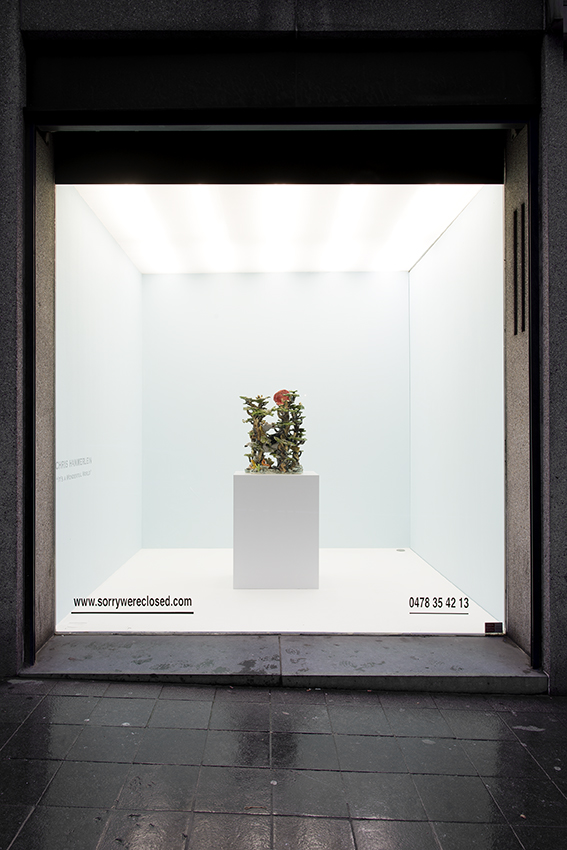
About
A pale blue cube suggesting a vast, open sky contains a forest greeting the visitor from the street. Sinking into the forest canopy is a sun and below, through a screen of dark leaves and dark trunks is seen a flash of white. There is action, something happening, but a clear view of the story is fragmented by shelves of leaves and branches. The face of a horse, terrified can be discerned and after some study we make out the identity of a black form attacking the horse, a panther clinging to the back of the horse as he bites into the neck of his startled prey. The forest is full of danger. It’s a Wonderful World.
Jiminey Cricket! When entering the gallery, one is initially confronted by an ocean wave, then off to the right one’s eyes are sent down two conical gilded tubes, shot through pipes and blasted from the frothy blue trumpet face of ‘Untitled No.3’ a sign of sound sent traveling over and across the feet of a lady who flails under the weight of a lion, struggling against his forced affections, a couple nestled in a paradisical mattress of fauna and flora, a love couple with an owl as witness to the wrestlers. A snake wriggles through the fingers of the victim. An orange field lily stands indifferent. The branches of a broken tree echo trumpet forms of abstract sculpture around the room.
On the central table clay is turned into water. Courbet and Hokusai come to mind.Wave after wave rises, cresting around a peninsula of two trees, one of which drips snow like wax off a menora weeping white time, the branches and ground are covered with soggy snow. The snow is shot through with rivulets formed earlier in the day but now the day is leaving, it is dusk, and the temperature is lowered by the setting sun, icy crusts are forming in the saturated soil. The time of day and season are in transition. Anyway... there is now the small tree. Covered in snow, a snow that during the day, has partially melted in early spring, an awakening soil wakening open to a softened earth, a soggy cushion of mud and moss and stiff bent grasses drooped with layers of sagging snow. The hour has come, the dark deepening drop in temperature has begun to stiffen the water, and forms a crust of ice in the snow, crunchy and dirty. Spring comes. The sculpture is intended to evoke a melancholic mood, to illustrate what the Japanese call, ‘wabi-sabi’, a gentle, sad observation and acceptance of transience, an aesthetic best characterized as a crow standing alone on a snow-covered branch at sunset.
Then, another wide-mouthed abstract piece, ‘Untitled No. 1’ stares the viewer down the throat. It is playful, a rubber band of color twanging away, pipes, hollow tubes and fifes suggesting again sound. It stands on a legged plinth of bare wood, emphasizing materials. Beyond the abstract piece stands a sculpture bearing some of the outlines of structure of ‘Untitled No.1’, and it has taken on the form of a dollar sign. With its title, ‘More’, it is made up of wounded trunks, and leaves and a serpent threaded in S-shape between the wood which is bleeding sap from an orifice, a beetle making its way down .
Next to ‘More’ stands ‘The Lesser Elk’, where now, a lion has embraced an elk in a ruined forest, another romantic couple. The Elk bellows a call caught between the trunks of wormy beetle-eaten trees, on his Sisyphean ascent, up a cliffside full of critters the spiked rays of a setting sun high-lighting the pair behind the arched back and mane of the lion. The roots of an uprooted tree are exposed, dislodging moss, pebbles, snails, and snakes. Life, death and again life churn.
Situated next on the altar for the viewer is presented a smaller version, at another temperature, of a scene of snow on branches at sunset.
This brings us to the witness to the show, the axel around which the room rotates, a wind-blown poplar, pushed and tossed by the wind, the cold Atlantic wind that blows the crown of waves which riots around the trees. The waves are each of a different temperature and moods of the ocean can be interpreted by color and texture of foam.There is a constant restlessness of natural forces, billowing back and forth, endless.
Existence takes many forms, all of the same primordial material always changing in the dream of Brahma. The dreamer is the dream.
— CH